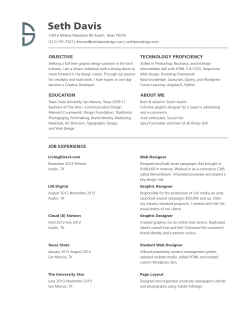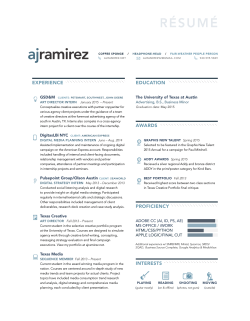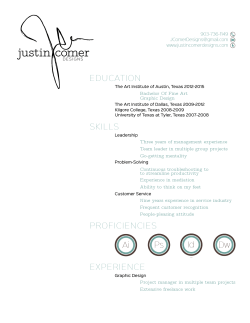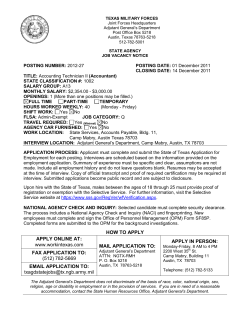
Creating linear models for data
Student: Class: Date: Creating linear models for data Student Activity Sheet 4; use with Exploring “Transformations on linear functions” 1. Look again at the graph of the data from the guessing game played by the social studies class. Compare the graph of the trend line, y = 2x – 30, to the graph of the "perfectguess" line y = x. What do they have in common? How are they different? 2. What is the parent function for linear functions? 3. How do other linear functions compare to the parent function? 4. Explain how the rate of change of a linear function affects the graph of the function. Copyright 2014 Agile Mind, Inc. Content copyright 2014 Charles A. Dana Center, The University of Texas at Austin Page 1 of 9 With space for student work Student: Class: Date: Creating linear models for data Student Activity Sheet 4; use with Exploring “Transformations on linear functions” 5. Explain how positive and negative values for slope affect the graph of a line. 6. How does the graph of y = 2x – 30 compare in steepness to the graph of its parent, y = x? What causes this difference in the two graphs? 7. Consider the graph of any line compared to its parent. Explain how the y-intercept makes the graph of any line different from the graph of its parent. 8. Consider the y-intercept of the graph of y = 2x – 30. Why is it different than the graph of the parent function, y = x? Copyright 2014 Agile Mind, Inc. Content copyright 2014 Charles A. Dana Center, The University of Texas at Austin Page 2 of 9 With space for student work Student: Class: Date: Creating linear models for data Student Activity Sheet 4; use with Exploring “Transformations on linear functions” 9. How would you transform the graph of y = x to produce the graph of y = 3x + 1? 10. How would you transform the graph of y = x to produce 1 the graph of y = x -3? 2 11. How would you transform the graph of y = x to produce the graph of y = -3x + 2? Copyright 2014 Agile Mind, Inc. Content copyright 2014 Charles A. Dana Center, The University of Texas at Austin Page 3 of 9 With space for student work Student: Class: Date: Creating linear models for data Student Activity Sheet 4; use with Exploring “Transformations on linear functions” 12. Explain in terms of transformations how the graphs of y = 16 + 0.07x and y = 26.1 + 0.07x are related to each other. 13. To summarize, what characteristics of the graph of the parent function, y = x, do you have to change to get any other linear graph? Copyright 2014 Agile Mind, Inc. Content copyright 2014 Charles A. Dana Center, The University of Texas at Austin Page 4 of 9 With space for student work Student: Class: Date: Creating linear models for data Student Activity Sheet 4; use with Exploring “Transformations on linear functions” 14. Match the graph of each transformation with its verbal description. 2 as steep as the graph of 3 f(x) = x, shifted down 6 units A graph that is The graph of f(x) = x with a rate of 2 change of and shifted down 1 unit 3 The linear parent function reflected across the x-axis and shifted up 2 The graph of f(x) = x shifted up 2 and with a rate of change of 3 The graph of f(x) x shifted up 2 units 2 The graph of f(x) x 5 reflected 3 over the x-axis and shifted down 6 units Copyright 2014 Agile Mind, Inc. Content copyright 2014 Charles A. Dana Center, The University of Texas at Austin Page 5 of 9 With space for student work Student: Class: Date: Creating linear models for data Student Activity Sheet 4; use with Exploring “Transformations on linear functions” 15. How does the graph of each of these functions compare with the graph of f(x) = x? a. f(x) – 2 b. f(x – 2) Copyright 2014 Agile Mind, Inc. Content copyright 2014 Charles A. Dana Center, The University of Texas at Austin Page 6 of 9 With space for student work Student: Class: Date: Creating linear models for data Student Activity Sheet 4; use with Exploring “Transformations on linear functions” 16. How does the graph of each of these functions compare with the graph of f(x) = x? a. 3f(x) b. f(3x) Copyright 2014 Agile Mind, Inc. Content copyright 2014 Charles A. Dana Center, The University of Texas at Austin Page 7 of 9 With space for student work Student: Class: Date: Creating linear models for data Student Activity Sheet 4; use with Exploring “Transformations on linear functions” c. —f(x) d. f(—x) Copyright 2014 Agile Mind, Inc. Content copyright 2014 Charles A. Dana Center, The University of Texas at Austin Page 8 of 9 With space for student work Student: Class: Date: Creating linear models for data Student Activity Sheet 4; use with Exploring “Transformations on linear functions” 17. REINFORCE For each transformation described below, sketch the graph that results. Then, write the function rule that represents the transformation. Use a single graph grid for all four graphs, and label each graph with the appropriate letter. a. Shift the graph of y = x down 2 units. Function rule: b. Shift the graph from part a up 5 units. Function rule: c. Reflect the graph from part b over the x-axis. Function rule: d. Create a graph with the same y-intercept as the graph in part c, but with 4 times the rate of change. Function rule: Copyright 2014 Agile Mind, Inc. Content copyright 2014 Charles A. Dana Center, The University of Texas at Austin Page 9 of 9 With space for student work
© Copyright 2025









